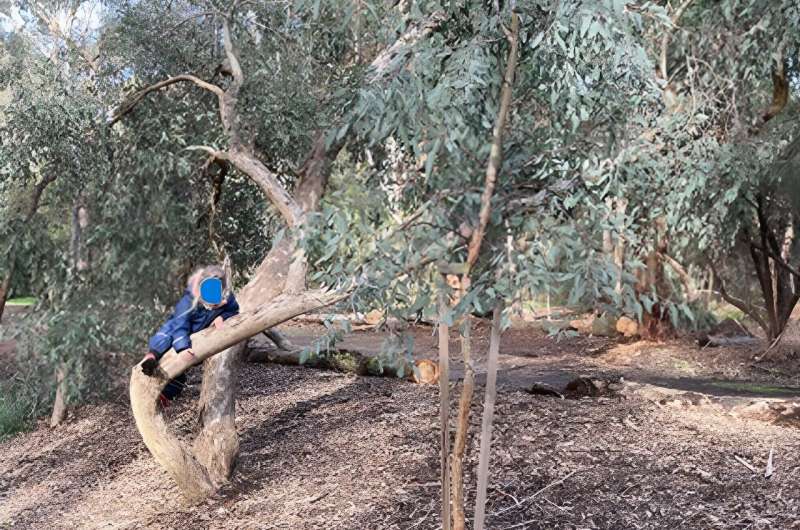May 7, 2024
Editors’ notes
This article has been reviewed according to Science X’s
editorial process
and policies.
Editors have highlighted
the following attributes while ensuring the content’s credibility:
fact-checked
trusted source
proofread

Risky play should be incorporated into early childhood science education in nature-based settings to lay early foundations for science education, says Deakin researcher.
In a new research paper published in the Early Childhood Education Journal, Dr. Chris Speldewinde, from Deakin University’s Center in Education, Research for Educational Impact (REDI), examined how educators use children’s risky play—like climbing and building campfires—to seek out opportunities to teach children about physical, chemical and biological science.
A ‘potent’ education tool
“In the realm of early childhood education, the fusion of risky play and science teaching has emerged as a potent tool for fostering children’s understanding of the natural world,” Dr. Speldewinde says.
Dr. Speldewinde analyzed existing research in early years science education, curriculum frameworks and early childhood learning programs, and visited bush kinder sites to observe pre-schoolers in action.
The findings underscore the intrinsic link between children’s exploration of risk and their scientific understanding, suggesting that exposure to risky play in natural settings facilitates experiential learning opportunities.
The study called out specific examples where educators used risky play as an opportunity to impart a scientific concept.
“When children navigate obstacles and balance on logs or engage in rough and tumble play, it provides opportunities for educators to impart knowledge about force and motion. By embracing risk, children not only develop physical skills but also deepen their understanding of scientific principles such as gravity when they fall out of a tree,” Dr. Speldewinde says.
“Similarly, messy play serves as a gateway to exploring chemical science. When children mix elements in nature, like earth and water to create mud, it offers educators opportunities to teach about material properties and transformations.”
The study also highlighted the intersection of risky play with biological science. Researchers observed children navigating the inherent risks of natural environments, from encounters with wildlife to handling fungi, and teachers explaining to children about ecosystems and life cycles.
With risk comes reward
Dr. Speldewinde says that in recent years, advocates of early childhood education and care have raised concerns regarding the availability for children to access opportunities to develop resilience and self-regulation through adventures and risk-taking.
“Safety legislation in Western societies has been a contributor to planning and organizing play environments and how children’s play is organized.
“Research has found that risk management guidelines are likely to restrict free play in nature, thus limiting children’s development and learning opportunities.”
Growing popularity of Bush Kinder
Bush Kinders—either standalone programs or programs incorporated into early childhood settings like kindergartens and childcare centers—have been growing in popularity in Australia since the 2010s.
Previous research led by Dr. Speldewinde showed that preschool aged children who participate in “Bush Kinder” programs could have better education outcomes than those who stay indoors. Co-authored by Deakin Professor Coral Campbell, the 2022 study found girls benefit from engaging in non-gendered outdoor play because it allows greater freedom to play creatively with unstructured natural materials.
“We know the benefits children derive from spending time in nature, however research in this area, particularly concerning science education opportunities, has been limited,” Dr. Speldewinde says.
“Further research is needed to explore how risky play influences children’s long-term engagement with science and STEM disciplines. By fostering a deeper affinity with science in nature through risky play, educators can lay the groundwork for lifelong curiosity and learning.”
More information:
Christopher Speldewinde, ‘Don’t Pick, Don’t Lick’: Connecting Young Children’s Risky Play in Nature to Science Education in Australian Bush Kinders, Early Childhood Education Journal (2024). DOI: 10.1007/s10643-024-01661-5
Provided by
Deakin University
Citation:
Risky outdoor play can boost science education (2024, May 7)
retrieved 9 May 2024
from https://phys.org/news/2024-05-risky-outdoor-play-boost-science.html
This document is subject to copyright. Apart from any fair dealing for the purpose of private study or research, no
part may be reproduced without the written permission. The content is provided for information purposes only.
Explore further
What are bush kinders? And what makes a good one?
1 shares
Feedback to editors
